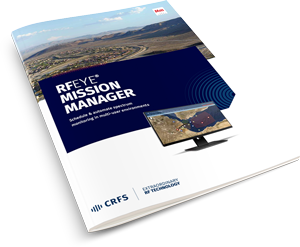CRFS launches range of RFeye Nexus modules for SIGINT applications

CRFS launches range of RFeye Nexus modules for SIGINT applications
80 MHz real-time bandwidth, 150 GHz/s, PCIe data streaming
CAMBRIDGE, UK, and DSEI, ExCeL LONDON (Stand S3-320): 10 September 2013 — CRFS, a leader in RF spectrum monitoring systems, has announced the launch at DSEI 2013 of its RFeye® Nexus range of wideband receiver modules, featuring class-leading signal interception capability and flexible PCIe interfacing for easy integration into other systems.
Designed for the most demanding signals intelligence (SIGINT) applications, the RFeye Nexus range offers 80 MHz real-time bandwidth from either 100 kHz to 18 GHz or 100 kHz to 6 GHz. Each module is capable of sweeping at 150 GHz/s with excellent noise characteristics for reliable capture of all signals, including short-burst events.
The RFeye Nexus range is modular and has flexible backplane and interface options, allowing modules to be installed in any suitable enclosure and easily connected to power, PCIe, trigger and reference sources. Modules can be supplied as VITA 3U rack-mountable cards with VPX backplane for integration with the broader sensor arrays typically found in SIGINT or EW systems. They can also be provided as integrator modules with custom fitment and a PCIe connector capable of supporting full IQ data streaming. Finally, a fully standalone option is available in an IP67 enclosure with PCIe Edge connectivity for users wanting a deployment-ready system. This option also supports a Linux-based control card for on-board data processing and autonomous operation with an optional optical fibre interface for data streaming.
“The RFeye Nexus range is based on our latest superheterodyne receiver design and gives outstanding performance,” said Alistair Massarella, CEO of CRFS. “The extremely low noise and spurious levels allow us to distinguish very low power signals from the noise floor, and thus to find transmissions that might be missed by other SIGINT systems. The high sweep speed also makes it possible to capture and analyse all activity across the spectrum up to 18 GHz.”
Multiple RF input ports allow comparison of signals from different antennas, and support direction finding. Timing and synchronisation features allow correlation of data between multiple modules for accurate geolocation of target signals using Time Difference of Arrival (TDOA) or Power on Arrival (POA) techniques. The RFeye Nexus range is supported by the existing RFeye suite of software, and modules can be deployed as part of the end-to-end RFeye Detect or RFeye Secure solutions for wide area and in-building monitoring.
Editorial contact details:
Nicholas Balon, General Manager
Tel: +44 (0)7590 446 092 Email: media@crfs.com
Malcolm Levy, Vice President, CRFS (North America)
Tel: +1 949-413-1024 Email: media@crfs.com
PR contacts:
Helen Duncan, Debra Seifert Communications (Europe)
Tel: +44 (0)7765 250610 Email: helen@debraseifert.com
Debra Seifert, Debra Seifert Communications (North America/Asia)
Tel: +1 (503) 626-7539 Email: debra@debraseifert.com
About CRFS
CRFS pioneered the concept of remote distributed real-time software-defined networks of intelligent spectrum sensors to provide continuous 24/7 monitoring of the RF environment. The RFeye was developed to help improve the efficiency of modern-day spectrum usage, resolve complex interference issues and provide cyber security for critical buildings and installations.
For more information please visit www.crfs.com
Watch the webinar
HOW TO RECORD AND EXTRACT SIGNALS FROM BIG RF DATA
Watch the webinar to learn how to improve your RF data recording process and unleash the full potential of your spectrum monitoring system.

GET INSTANT NEWS UPDATES
Subscribe to the CRFS blog to recieve RF news, straight to your inbbox